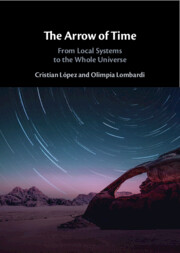Book contents
- The Arrow of Time
- The Arrow of Time
- Copyright page
- Contents
- Contributors
- Preface
- Acknowledgments
- Part I Local Systems
- Part II The Arrow of Time and Philosophical Issues
- Part III The Arrow of Time and Time-Reversal Invariance
- 8 Time for Pancakes: Time Reversal and Ontology
- 9 Insights into Quantum Time Reversal from the Classical Schrödinger Equation
- 10 Saving the Appearances: The Direction of Time and Time-Reversal Invariance
- Part IV The Whole Universe
- Index
- References
8 - Time for Pancakes: Time Reversal and Ontology
from Part III - The Arrow of Time and Time-Reversal Invariance
Published online by Cambridge University Press: 28 October 2025
- The Arrow of Time
- The Arrow of Time
- Copyright page
- Contents
- Contributors
- Preface
- Acknowledgments
- Part I Local Systems
- Part II The Arrow of Time and Philosophical Issues
- Part III The Arrow of Time and Time-Reversal Invariance
- 8 Time for Pancakes: Time Reversal and Ontology
- 9 Insights into Quantum Time Reversal from the Classical Schrödinger Equation
- 10 Saving the Appearances: The Direction of Time and Time-Reversal Invariance
- Part IV The Whole Universe
- Index
- References
Summary
According to the standard account of time reversal, namely the account found in physics books, a time-reversal transformation involves a temporal operator 𝑇 that, when acting on a sequence of states, inverts the order with which states happen, and suitably changes the properties of the entities in the state so as to make the theory time-reversal invariant. This ‘symmetry first’ approach imposes symmetries on the theory: the changes in the states are a consequence of requiring the theory to be time-reversal invariant. Some (Albert, Callender) find this view unjustified: we discover a theory has a given symmetry, on the basis of the theory’s ontology, not the other way around. So, they propose a ‘metaphysics first’ approach, sometimes dubbed ‘pancake account’ of time reversal: 𝑇 inverts the order of the states but does nothing else. Consequently, since there are no obvious independent reasons for the state to change as 𝑇 prescribes to preserve time-reversal symmetry, then the theory is not time-reversal invariant. In this chapter I wish to further motivate the pancake account of time reversal by arguing the standard account is far more problematical than has been suggested. Moreover, I defend the pancake account from recent objections raised by Roberts. Finally, since I value symmetries, I propose an alternative account, which aims at retaining the best of both approaches: the 𝑇 operator changes the order of the states, it leaves the state unaffected (like the pancake account), but also makes the theory time-reversal invariant (like the standard account).
Information
- Type
- Chapter
- Information
- The Arrow of TimeFrom Local Systems to the Whole Universe, pp. 161 - 183Publisher: Cambridge University PressPrint publication year: 2025
References
Accessibility standard: WCAG 2.1 AA
Why this information is here
This section outlines the accessibility features of this content - including support for screen readers, full keyboard navigation and high-contrast display options. This may not be relevant for you.Accessibility Information
Content Navigation
Allows you to navigate directly to chapters, sections, or non‐text items through a linked table of contents, reducing the need for extensive scrolling.
Provides an interactive index, letting you go straight to where a term or subject appears in the text without manual searching.
Reading Order & Textual Equivalents
You will encounter all content (including footnotes, captions, etc.) in a clear, sequential flow, making it easier to follow with assistive tools like screen readers.
You get concise descriptions (for images, charts, or media clips), ensuring you do not miss crucial information when visual or audio elements are not accessible.
Visual Accessibility
You will still understand key ideas or prompts without relying solely on colour, which is especially helpful if you have colour vision deficiencies.
Structural and Technical Features
You gain clarity from ARIA (Accessible Rich Internet Applications) roles and attributes, as they help assistive technologies interpret how each part of the content functions.
